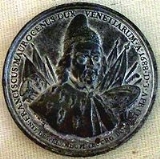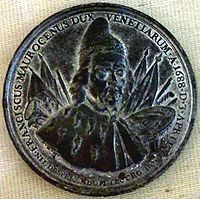
Francesco Morosini
Encyclopedia
Francesco Morosini was the Doge
of Venice
from 1688 to 1694, at the height of the Great Turkish War
. He was a member of a famous noble Venetian
family (the Morosini family) which produced several Doge
s and generals.
during the siege of Candia
by the Ottoman Empire
. He was eventually forced to surrender the city, and was accused of cowardice and treason on his return to Venice; however, he was acquitted after a brief trial.
In 1685, at the outbreak of the Morean War
, Morosini took command of a fleet against the Ottomans and sacked Koroni
. Over the next several years, he captured most of the Morea
with the help of Otto Wilhelm Königsmarck
. His fame reached such heights that he was given the victory title
Peloponnesiacus, and was the first Venetian citizen to have a bronze bust placed during his own lifetime in the Great Hall, with the inscription Francisco Morosini Peloponnesiaco, adhuc vivendi, Senatus.
, attacked Euboea
, but was unable to capture it, and was forced to return to Venice
when plague broke out among his troops. He embarked on a final campaign in 1693, but was again unsuccessful in taking Negropont, and returned to Venice after sacking some minor coastal towns. After his death in 1694, a large marble arch was placed in his honor at the Doge's Palace, while his cat —of which Morosini was notably fond— was embalmed and taken to the Museo Correr
.

Doge
Doge is a dialectal Italian word that descends from the Latin dux , meaning "leader", especially in a military context. The wife of a Doge is styled a Dogaressa....
of Venice
Republic of Venice
The Republic of Venice or Venetian Republic was a state originating from the city of Venice in Northeastern Italy. It existed for over a millennium, from the late 7th century until 1797. It was formally known as the Most Serene Republic of Venice and is often referred to as La Serenissima, in...
from 1688 to 1694, at the height of the Great Turkish War
Great Turkish War
The Great Turkish War refers to a series of conflicts between the Ottoman Empire and contemporary European powers, then joined into a Holy League, during the second half of the 17th century.-1667–1683:...
. He was a member of a famous noble Venetian
Republic of Venice
The Republic of Venice or Venetian Republic was a state originating from the city of Venice in Northeastern Italy. It existed for over a millennium, from the late 7th century until 1797. It was formally known as the Most Serene Republic of Venice and is often referred to as La Serenissima, in...
family (the Morosini family) which produced several Doge
Doge
Doge is a dialectal Italian word that descends from the Latin dux , meaning "leader", especially in a military context. The wife of a Doge is styled a Dogaressa....
s and generals.
Early career
Morosini first rose to prominence as Captain-General of the Venetian forces on CreteCrete
Crete is the largest and most populous of the Greek islands, the fifth largest island in the Mediterranean Sea, and one of the thirteen administrative regions of Greece. It forms a significant part of the economy and cultural heritage of Greece while retaining its own local cultural traits...
during the siege of Candia
Siege of Candia
The Siege of Candia was a military conflict in which Ottoman forces besieged the Venetian-ruled city and were ultimately victorious. Lasting from 1648 to 1669, it was the longest siege in history.-Background:...
by the Ottoman Empire
Ottoman Empire
The Ottoman EmpireIt was usually referred to as the "Ottoman Empire", the "Turkish Empire", the "Ottoman Caliphate" or more commonly "Turkey" by its contemporaries...
. He was eventually forced to surrender the city, and was accused of cowardice and treason on his return to Venice; however, he was acquitted after a brief trial.
In 1685, at the outbreak of the Morean War
Morean War
The Morean War is the better known name for the Sixth Ottoman–Venetian War. The war was fought between 1684–1699, as part of the wider conflict known as the "Great Turkish War", between the Republic of Venice and the Ottoman Empire...
, Morosini took command of a fleet against the Ottomans and sacked Koroni
Koroni
Koroni or Coroni is a town and a former municipality in Messenia, Peloponnese, Greece. Since the 2011 local government reform it is part of the municipality Pylos-Nestoras, of which it is a municipal unit. Known as Corone by the Venetians and Ottomans, the town of Koroni Koroni or Coroni is a...
. Over the next several years, he captured most of the Morea
Morea
The Morea was the name of the Peloponnese peninsula in southern Greece during the Middle Ages and the early modern period. It also referred to a Byzantine province in the region, known as the Despotate of Morea.-Origins of the name:...
with the help of Otto Wilhelm Königsmarck
Otto Wilhelm Königsmarck
Count Otto Wilhelm Königsmarck was a Swedish military officer from Minden. He attained the rank of field marshal in 1676, commanded the Battle of Stralsund , and became Governor General for Swedish Pomerania in 1679. He was the son of Hans Christoff Königsmarck and the brother of Conrad Christoff...
. His fame reached such heights that he was given the victory title
Victory title
A victory title is an honorific title adopted by a successful military commander to commemorate his defeat of an enemy nation. This practice was first used by Ancient Rome and is still most commonly associated with the Romans, but it has also been adopted as a practice by many modern empires,...
Peloponnesiacus, and was the first Venetian citizen to have a bronze bust placed during his own lifetime in the Great Hall, with the inscription Francisco Morosini Peloponnesiaco, adhuc vivendi, Senatus.
Destruction of the Parthenon
During the siege of Athens in 1687, his artillery turned the Parthenon from a functioning building to a simple ruin, and he personally oversaw the looting of some of the surviving sculptures. The Parthenon was used as a powder magazine by the Ottomans when on September 26, 1687 Morosini's cannons scored a direct hit on the edifice. An attache of the Swedish field commander General Otto Wilhelm Königsmarck wrote later: "How it dismayed His Excellency to destroy the beautiful temple which had existed three thousand years!". By contrast Morosini, who was the commander in chief of the operation, described it in his report to the Venetian government as a "fortunate shot". Not satisfied with the destruction he had wrought so far, Morosini tried to loot Athena's horses but the attempt resulted in the works being smashed to bits on the rock below. The Ottoman Empire regained possession of the monument in the following year and having noticed the demand began to sell souvenirs to Westerners.Doge
In the summer of 1688 Morosini, now having been proclaimed DogeDoge
Doge is a dialectal Italian word that descends from the Latin dux , meaning "leader", especially in a military context. The wife of a Doge is styled a Dogaressa....
, attacked Euboea
Euboea
Euboea is the second largest Greek island in area and population, after Crete. The narrow Euripus Strait separates it from Boeotia in mainland Greece. In general outline it is a long and narrow, seahorse-shaped island; it is about long, and varies in breadth from to...
, but was unable to capture it, and was forced to return to Venice
Republic of Venice
The Republic of Venice or Venetian Republic was a state originating from the city of Venice in Northeastern Italy. It existed for over a millennium, from the late 7th century until 1797. It was formally known as the Most Serene Republic of Venice and is often referred to as La Serenissima, in...
when plague broke out among his troops. He embarked on a final campaign in 1693, but was again unsuccessful in taking Negropont, and returned to Venice after sacking some minor coastal towns. After his death in 1694, a large marble arch was placed in his honor at the Doge's Palace, while his cat —of which Morosini was notably fond— was embalmed and taken to the Museo Correr
Museo Correr
The Museo Correr is the civic museum of Venice, located in the Piazza San Marco, and is entered by the ceremonial stairway in the Ala Napoleonica at the western end of the Piazza opposite the church of San Marco at the other end...
.
Commemoration

- The Scuola Navale Militare Francesco Morosini is named for him
- The Ruggiero di Lauria-classRuggiero di Lauria class battleshipThe Ruggiero di Lauria class was a class of Italian battleships which served in the Regia Marina during the late 19th and early 20th centuries...
battleshipBattleshipA battleship is a large armored warship with a main battery consisting of heavy caliber guns. Battleships were larger, better armed and armored than cruisers and destroyers. As the largest armed ships in a fleet, battleships were used to attain command of the sea and represented the apex of a...
Francesco MorosiniItalian battleship Francesco Morosini (1885)The first Francesco Morosini was an Italian battleship launched in 1885. She was the second ship of the Ruggiero di Lauria-class pre-dreadnoughts, and served in the Regia Marina during the late 19th and early 20th centuries....
, launchedShip naming and launchingThe ceremonies involved in naming and launching naval ships are based in traditions thousands of years old.-Methods of launch:There are three principal methods of conveying a new ship from building site to water, only two of which are called "launching." The oldest, most familiar, and most widely...
on 30 July 1885, completed in 1889, and stricken in 1909, was named for him - The Caracciolo-classCaracciolo class battleshipThe Caracciolo class battleships were designed for the Italian Regia Marina in 1912-1913, and ordered in 1914, but never completed. The four ships of the class were intended to be the equivalent of the British and the answer to the Austro-Hungarian ....
battleship Francesco Morosini, laid down in 1915 but scrapped in 1921 prior to launching, was named for him
See also
- ParthenonParthenonThe Parthenon is a temple on the Athenian Acropolis, Greece, dedicated to the Greek goddess Athena, whom the people of Athens considered their virgin patron. Its construction began in 447 BC when the Athenian Empire was at the height of its power. It was completed in 438 BC, although...
- Elgin MarblesElgin MarblesThe Parthenon Marbles, forming a part of the collection known as the Elgin Marbles , are a collection of classical Greek marble sculptures , inscriptions and architectural members that originally were part of the Parthenon and other buildings on the Acropolis of Athens...

